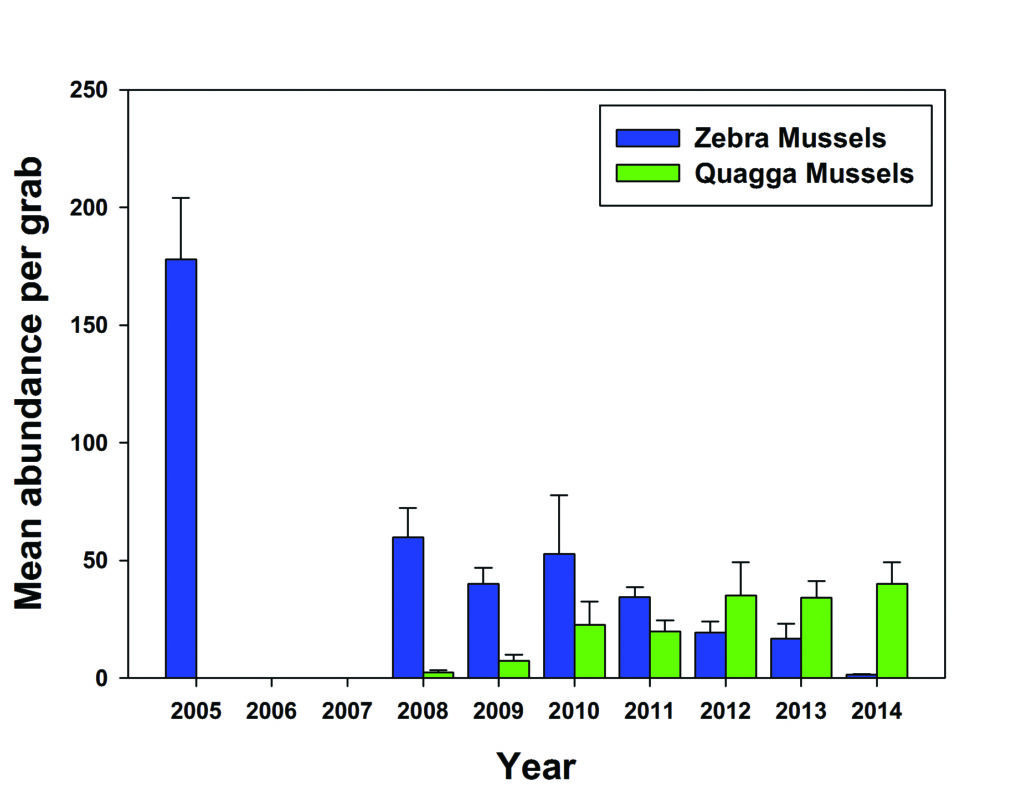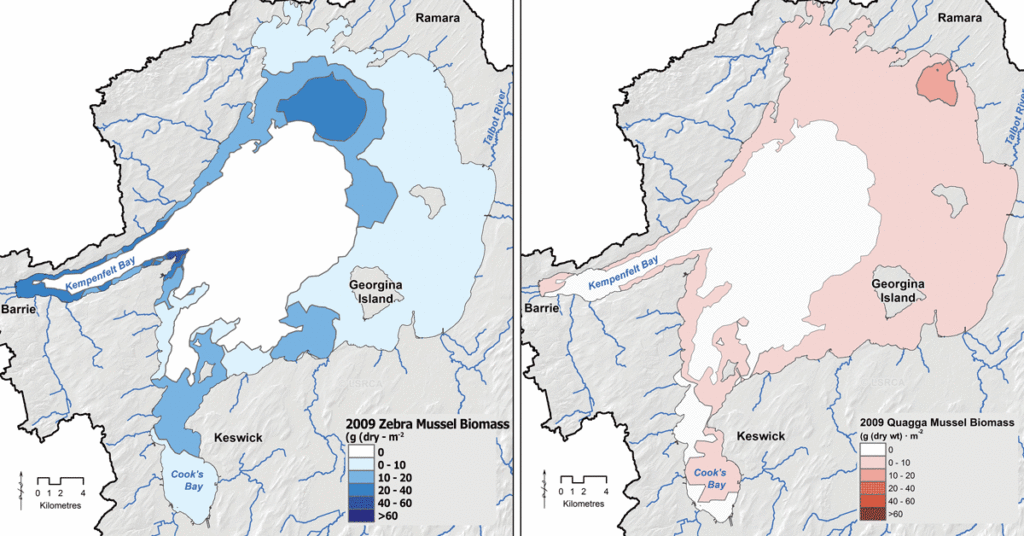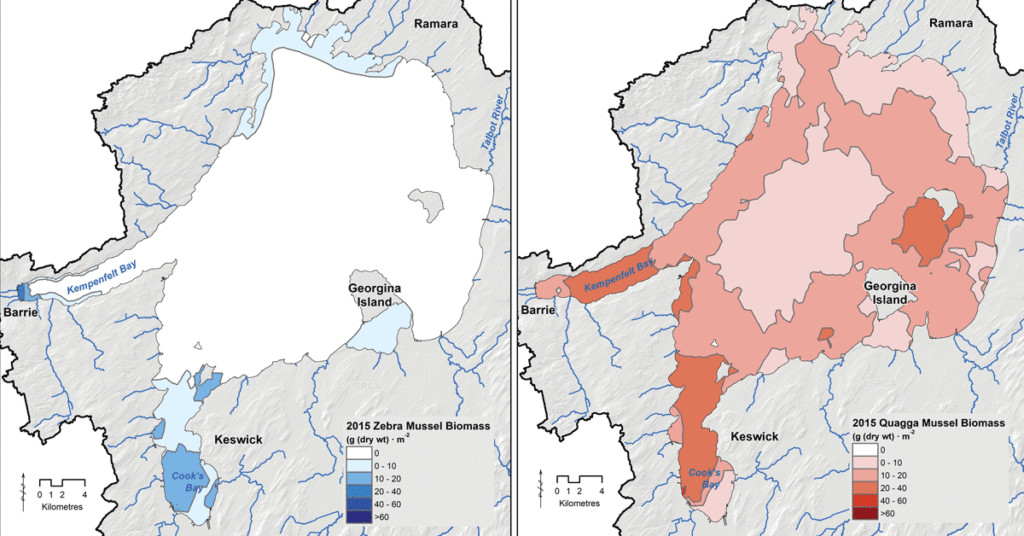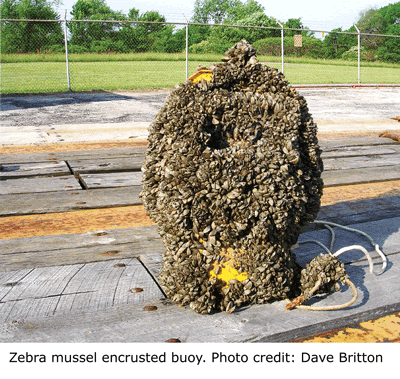
Lake Simcoe Science
Mussel Loss, Mussel Gain
In 2012, LSRCA published a Science Newsletter showing where invasive zebra and quagga mussels were found in Lake Simcoe, and how they have changed the ecology of the lake since their arrival. Since then some remarkable changes have occurred, worthy of another chapter.
In this newsletter, we examine how the invasive mussel population has shifted from a predominately zebra mussel population to predominately quagga mussels. We also explore what the implications may be for Lake Simcoe.
Zebra and Quagga Mussels
Zebra and quagga mussels are two of the most recognizable invasive species in Lake Simcoe, and across the Great Lakes Region. Both species are native to the Caspian-Black Sea Region of Eurasia and were carried to the Great Lakes in the ballast water of container ships.
Since then, they have been transported across North America by commercial shipping vessels, as well as by recreational boaters who did not practice “invasive species prevention” by cleaning boats and equipment when moving between lakes.

Zebra mussels (left) invaded Lake Simcoe in 1995. Closely related quagga mussels (middle) were first recorded in the lake in 2004. Quagga mussels also have a deep water form (right) that is adapted to living on mud and silt substrates.
Zebra Mussels Almost Gone in Lake Simcoe
To help us understand the changes in mussel population, LSRCA has monitored 51 sites in Lake Simcoe each year since 2005. We have recorded a large decline in zebra mussel populations and a corresponding increase in quagga mussels.
Zebra mussels have a survival strategy based on high reproduction to occupy as much space as possible. They also require a large amount of algae for food. The consequence of this strategy is that, a few years after their invasion, they “eat themselves out of house and home” and the population crashes.

Zebra and Quagga Mussel Abundance
The change in the number of zebra (blue bars) and quagga mussels (green bars) in a square metre of Lake Simcoe’s nearshore zone (water depth 2-20 m) since 2005.
While quagga mussels have been in the lake since 2004, they were at very low numbers until 2008.
2009 Zebra and Quagga Mussel Distribution in Lake Simcoe

2015 Zebra and Quagga Mussel Distribution in Lake Simcoe

To confirm the mussel trends recorded by our annual monitoring, in 2009 and 2015, LSRCA sampled over 700 sites in Lake Simcoe for invasive mussels. At each site, mussels were collected and brought back to the lab where they were identified, counted, and measured for shell length. These maps show how the population of zebra mussels (blue) and quagga mussels (red) has changed between 2009 (top) and 2015 (bottom).
Quagga Mussels Have “Muscled” In!
With the zebra mussel population declining, quagga mussels were able to colonize habitats that were previously occupied by zebra mussels. As such, their population has increased rapidly.
Though quagga mussels have a similar life strategy to zebra mussels, they also have several advantages that make them more competitive. First, it takes longer for the quagga mussel population to peak, which means their numbers are still increasing in Lake Simcoe. Second, quagga mussels can survive on fewer food particles than zebra mussels, so they are more efficient under the low algae concentrations that starved the zebra mussels. Third, quagga mussels are active at lower temperatures (4o C) compared to zebra mussels (12o C), so they have a longer season for acquiring food, growing, and reproducing.
Lastly, in Lake Simcoe, zebra mussels are limited to water depths of less than 20 metres, because of a change in the bottom substrate from hard packed sand, shells and cobble to fine silt and mud. These silts and mud clog the zebra mussel feeding structures, limiting growth and survival. Quagga mussels, particularly the deep water form, have no problem feeding in these fine sediments.
2009 vs 2015 Mussel Study Results
| | 2009 | 2015 |
|---|---|---|
| Per cent Zebra Mussels | 84 | 12 |
| Per cent Quagga Mussels | 16 | 88 |
| Abundance (mussels/m2) | 2300 | 1463 |
| Biomass (grams of mussels/m2) | 11.5 | 15.7 |
Results of 2009 study where the mussel population was 84 per cent zebra mussels, compared with a 2015 study being 88 per cent quagga mussels. While there were fewer mussels per square metre in 2015, quagga mussels have a larger average size and are more widespread in the Lake
New Mussel on the Block
As seen in the maps above showing mussel populations in 2009, there is a large white area in the central part of Lake Simcoe’s main basin, and at the deepest spot (42 metres) of Kempenfelt Bay, showing where no mussels were found. However, in 2015, you can see quagga mussels have invaded these deep waters, while zebra mussels are only present in a small part of the nearshore zone. This colonization of the deep water is the largest change in mussel distribution we have seen in Lake Simcoe since the initial invasion by zebra mussels in 1995.
In our analyses, LSRCA confirmed the presence of a second type of quagga mussel, a form specifically adapted to living on muddy substrates. These quagga mussels stick together, forming a ball (known as “druses”), lifting the mussels above the filter-clogging silt. They also have longer feeding structures that can stick out of the mud to collect food, rather than being smothered by silt.
Another feature of the deep water quagga mussels is that they need less food and can use other nutrient-rich particles. This comes in handy when they are cut off from algae and food particles for a large part of the year, when the warm upper layer of water containing algae is separated from the cooler, deeper water. They only have access to algae when the water column is fully mixed, in early spring, late fall, and part of the winter.
What Does This Mean?
As a part of our monitoring program, LSRCA is investigating how this change from zebra mussels to quagga mussels and their invasion of deep water will impact Lake Simcoe. With very high filtering rates, both zebra and quagga mussels have removed algae and other particles from the water column (one reason Lake Simcoe has such clear water today) and changed how nutrients, such as phosphorus, are circulated in the lake. They greatly affected species diversity and the lake’s food web by creating more living space and nutrient-rich particles for animals like worms and larvae.

In 1995, when zebra mussels invaded the lake, they changed how nutrients were circulated by bringing more phosphorus into the near shore zones and away from offshore areas. With high filtration mussels in the deep water, will this circulation be reversed?
In Lake Michigan, where quaggas have also replaced zebra mussels, there has been a very large decline in algae during the period when the lake is mixed – algae that are a critical food source for native species.
Another change we are investigating in Lake Simcoe is the impact of quagga mussels on the fish community, particularly coldwater fish such as lake trout and lake whitefish. These fish use the deep water as a refuge during the summer. Sport fishers on the lake have reported fish stomachs containing mussels, so some species are using quagga mussels as a food source.
Also, our analyses show that deep water sites containing quagga mussels have a higher abundance and diversity of benthic invertebrates than sites with no quagga mussels. These invertebrates are a food source for coldwater fish, so an increase in food may result in an increase to lake trout and lake whitefish populations. Similar changes from zebra to quagga mussels have also been recorded in Lake Ontario, Central and Eastern Lake Erie, and Lake Michigan.
With the population changes taking place, it is even more important to monitor the environmental health and state of Lake Simcoe. Furthermore, the changes we are recording in Lake Simcoe (and similar lakes such as Lake Champlain and the New York Finger Lakes) can be used to understand changes in the larger Great Lakes that are more difficult to study.
Prevention is the key
- Learn how to identify zebra and quagga mussels and how to prevent accidentally spreading these invasive species.
- Inspect your boat, trailer and equipment after each use. Remove all plants, animals and mud before moving to a new waterbody.
- Drain water from motor, live well, bilge and transom wells while on land.
- Rinse all recreational equipment with high pressure (>250 psi), hot water (50°C / 122°F) OR let it dry in the sun for at least 5 days.
- If you find zebra or quagga mussels or other invasive species in the wild, please contact the Invading Species Hotline at 1-800-563-7711 (toll-free), or report a sighting at www.invadingspecies.com
Contact Customer Service:
Phone: 905-895-1281
Toll Free: 1-800-465-0437
Email: info@LSRCA.on.ca
